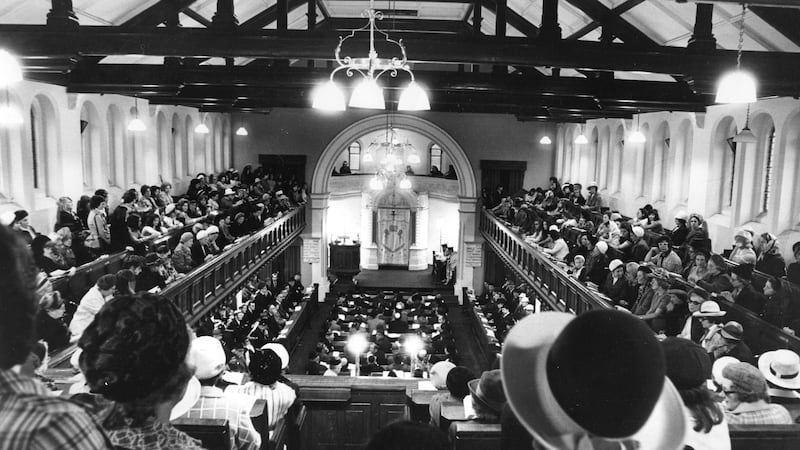In January 1942, with much of the continent under their control, senior Nazis gathered for a conference in Wannsee where the Final Solution was hatched. The inclusion of a single line – Irland 4000 – typed on the grim document listing the Jewish population of each country made it chillingly clear that Irish Jews were being included in Hitler’s macabre plans.
But with Ireland being one of the very few European countries whose Jewish population remained intact at the end of the second World War, was this actually down to luck or design? And how safe were the Jews in Ireland from the fate that befell so many others of that faith across the continent?
In 1937, two years before the outbreak of the war, Article 44 of Ireland’s new Constitution gave the Jewish community recognition and a right to exist within the country. This was a remarkable piece of legislation overseen by the de Valera goverment. Firstly, because the Jewish faith was being officially recognised and protected in a country where it was increasingly viewed that to be Irish one must be Catholic. But more importantly, it flew in the face of the anti-Semitism that was by then rampant elsewhere in Europe. The new Constitution was signed into law after a referendum, signifying Article 44 also had the backing of the people. However, for all its magnanimity, it is doubtful the new Constitution could have in any way protected Ireland’s Jewish community had there been a German victory.
In the early years of the war, the only obstacle standing in the way of that German victory was Ireland’s old foe and closest neighbour, Britain. With less than two decades of self-governance, the country’s diplomatic skills were suddenly tested to the core. At the outbreak of war, de Valera’s declaration of neutrality may have shaken Downing Street, but it had the support of the vast majority of Irish people.
The wounds and bitterness from the War of Independence were still too raw for Ireland to become Britain’s official ally in their fight against Germany. However, the onset of the world war did create the circumstances that required Britain and Ireland to work together as sovereign nations for the first time. De Valera’s cabinet found themselves in the uneasy position of having to trust and co-operate with their former enemy.
Downing Street, through gritted teeth, had to respect Ireland’s position of neutrality and to finally appoint an ambassador to the country. London had resisted establishing a legation in Dublin up to that point, fearing it would legitimise Ireland’s republican assertions. Sir John Maffey’s official title was that of the United Kingdom’s Representative to Ireland. He proved to be an invaluable link, building bridges between the two countries, especially after Churchill came to power in May 1940.
Two decades previously, in his post as minister of state for war, Churchill had supported the use of the Black and Tans in the War of Independence. In his next role, as minister of state for the colonies, he had been one of the signatories of the Anglo-Irish Treaty which de Valera so vehemently opposed and which plunged the country into civil war. With this cabinet position, Churchill was also in charge of transferring power from British to Irish hands after the treaty, which brought him into continual conflict with de Valera. Both men were to spend time in the political wilderness before, in a Shakespearean twist of events, the two adversaries came to power to lead their respective nations during Europe’s darkest hour.
Having captured the Channel Islands, Hitler’s war machine was by then on the doorstep of Britain and Ireland, forcing de Valera to work with his old nemesis, Churchill, while maintaining the official stance of neutrality.
In 1940 British intelligence informed their Irish counterparts of the existence of Operation Green, a detailed strategy drawn up by the German high command for the invasion of Ireland. The Irish began immediately to work with the British on their own secret military plans. This collaboration, codenamed Plan W, was a blueprint for the joint defence of Ireland in the event of a Nazi attack on the island. It was agreed that British forces would, once invited by Dublin, help to repel a German invasion.

For the Irish, less than 20 years after fighting the War of Independence and the resulting Civil War, to enter into an agreement with the British that would invite them back into the country, was extraordinary. For de Valera to trust and co-operate with his old enemy Churchill to such an extent demonstrates the understanding and fear the Dublin cabinet had of the terror the Nazis would bring with them.
There was also the realisation that no group was at more risk from that terror than the Jewish community. The world had watched in dismay as the persecution of the Jews intensified throughout the 1930s after Hitler came to power. With the German annexation of Austria in March 1938, a further 192,000 Jews found themselves in critical danger and desperate to leave that country also. In order to try and avert the growing humanitarian crisis an international conference was held in Evian in July 1938. Six months after ratifying the new constitution that enshrined the protection of Jews at home, Ireland sent a delgation to Evian to take part in the global effort to try to resolve the Jewish refugee emergency. The conference was unsuccessful as the 39 countries that participated failed to agree on quotas.
At the time, the world was still recoiling from the economic meltdown caused by the 1929 crash. Mass unemployment meant that countries felt they could not accommodate the Jews seeking refuge from Germany and Austria. Similar to the Syrian refugee crisis that engulfed Europe from 2015, there was a general alarm at being overwhelmed by migrants. The failure at Evian meant time quickly ran out for European Jews. The war that broke out the following year led to Jews across the Continent, who had previously believed they lived in safe territories, being suddenly at the mercy of the conquering German Wehrmacht.
The Jewish population of the occupied nations did fare differently depending on circumstances. Most at risk were German and Austrian refugees who had fled abroad only to find themselves again under the jurisdiction of their former government. They were rounded up and sent to the camps. The barbarity that the Nazis inflicted on the Slavic countries meant their Jewish citizens also faced annihilation. However, the Nazis were more careful in how they conducted themselves in occupied France. Co-operation with French authorities resulted in chiefly foreign Jews living in the country being arrested and deported. Jews who were French citizens mostly survived the war.
When German tanks rolled across the border into Denmark in 1940, they wished to foster good relations with their neighbours. The Danes, hopelessly outnumbered, negotiated with their new masters and maintained more autonomy than other conquered nations. This resulted in the Germans leaving Danish Jews alone to a greater extent, at least until Danish resistance began accelerating in 1943. Leonhard Kaupisch, the supreme military commander in charge of occupied Denmark, was appointed the commander in charge of Operation Green, the blueprint for the invasion of Ireland. This might imply the Nazis were expecting a similar type of occupation in Ireland as in Denmark. If this had been the case, then maybe Irish Jews would have been mostly left alone in the same way that the Danish ones had. However, de Valera’s pact with Churchill indicates that the Irish authorities intended to fight a Nazi invasion with all their might.
This robust defence of Ireland would inevitably result in the country becoming a bloody battleground, putting the Jewish population at much more risk. A better example of what could have occurred then would be the invasion of Norway. As the Norwegians actively fought the Germans the result was a more severe military dictatorship imposed there. Norway’s small Jewish population of less than two thousand was devastated – 795 were deported to the camps, where only 25 survived. The rest managed to flee to Sweden or the UK.
Rather than invade Ireland, the Nazis opted instead to intensify their assault on Britain. But Ireland remained in imminent danger as the Nazis had determined that Dublin would be one of their six administrative centres from where they would govern these islands in the postwar period after their expected victory.
It must have been terrifying time for the Jews in Ireland, who would have been aware of the rumours that German spies were everywhere and the uncertainty of their future in a world that had turned so viciously against them. Article 44 of the new Constitution must have given some solace and hope.
In 1966 the Dublin Jewish community planted a forest near Nazareth in Israel called the Eamon de Valera Forest in acknowledgment for the support the then president had given their community through his years in office. The 10,000-tree woodland remains flourishing today.
A Telegram From Berlin by Andrew O’Connor is published by Poolbeg



















